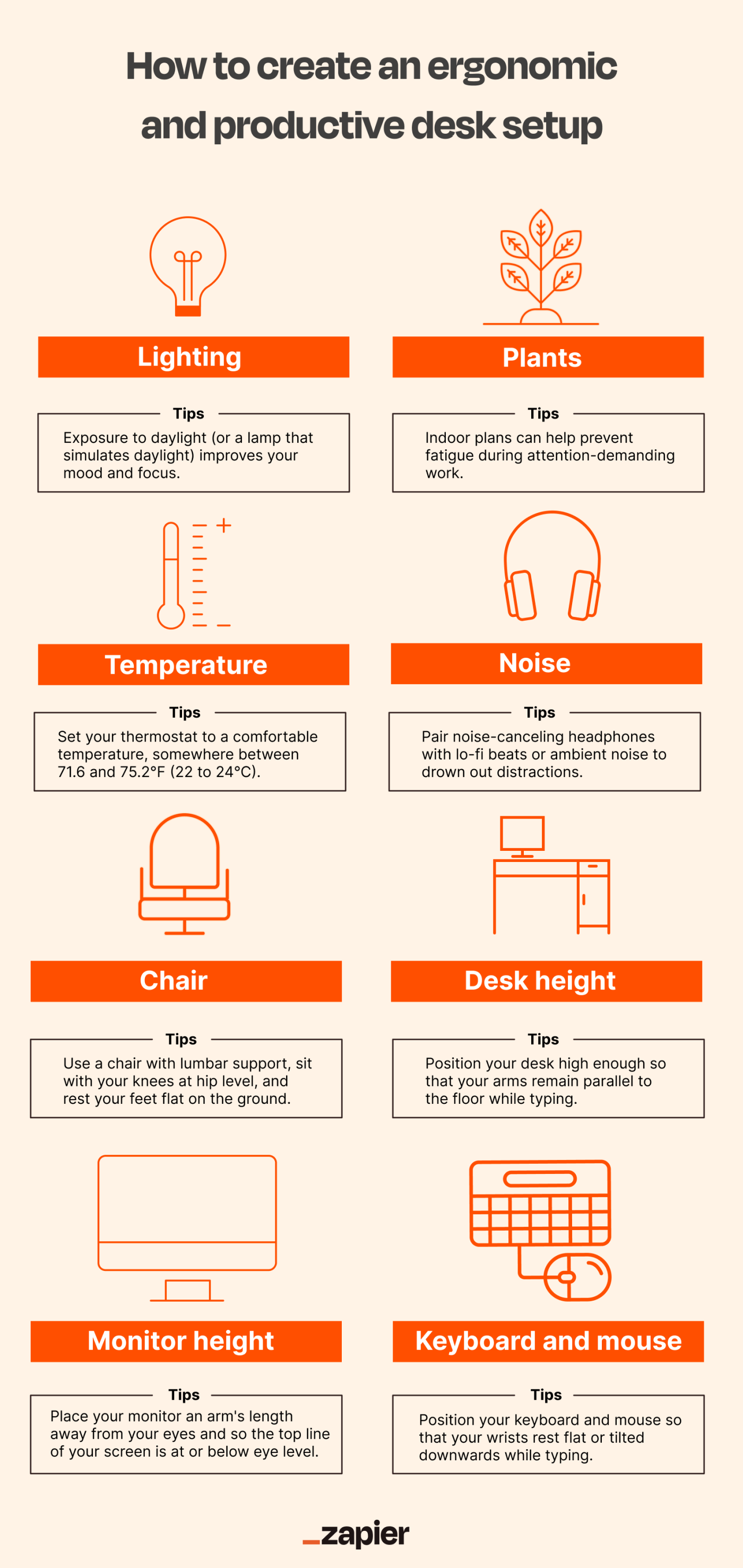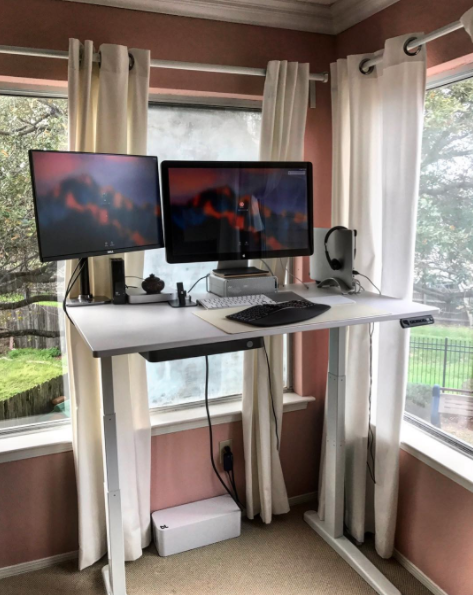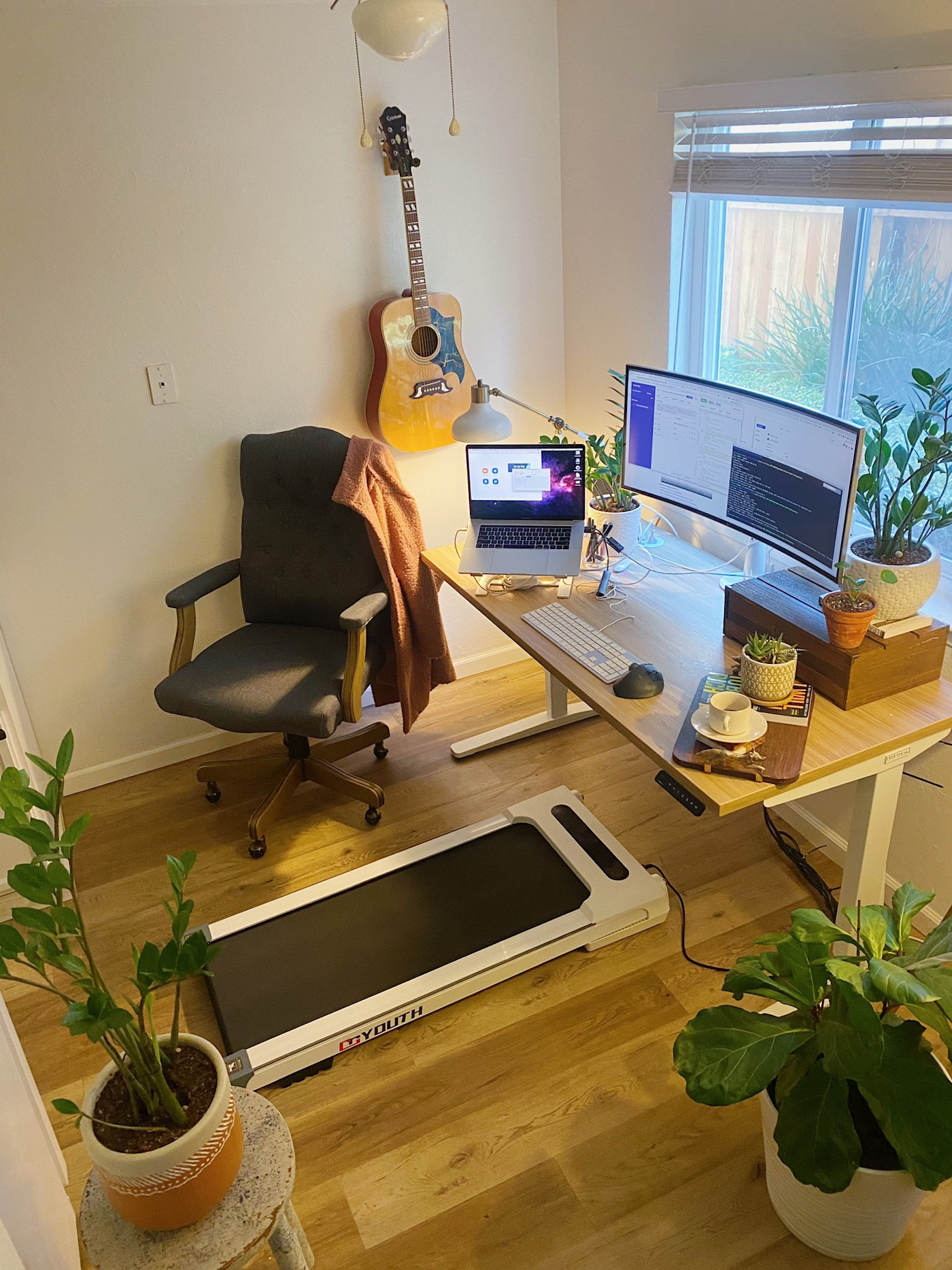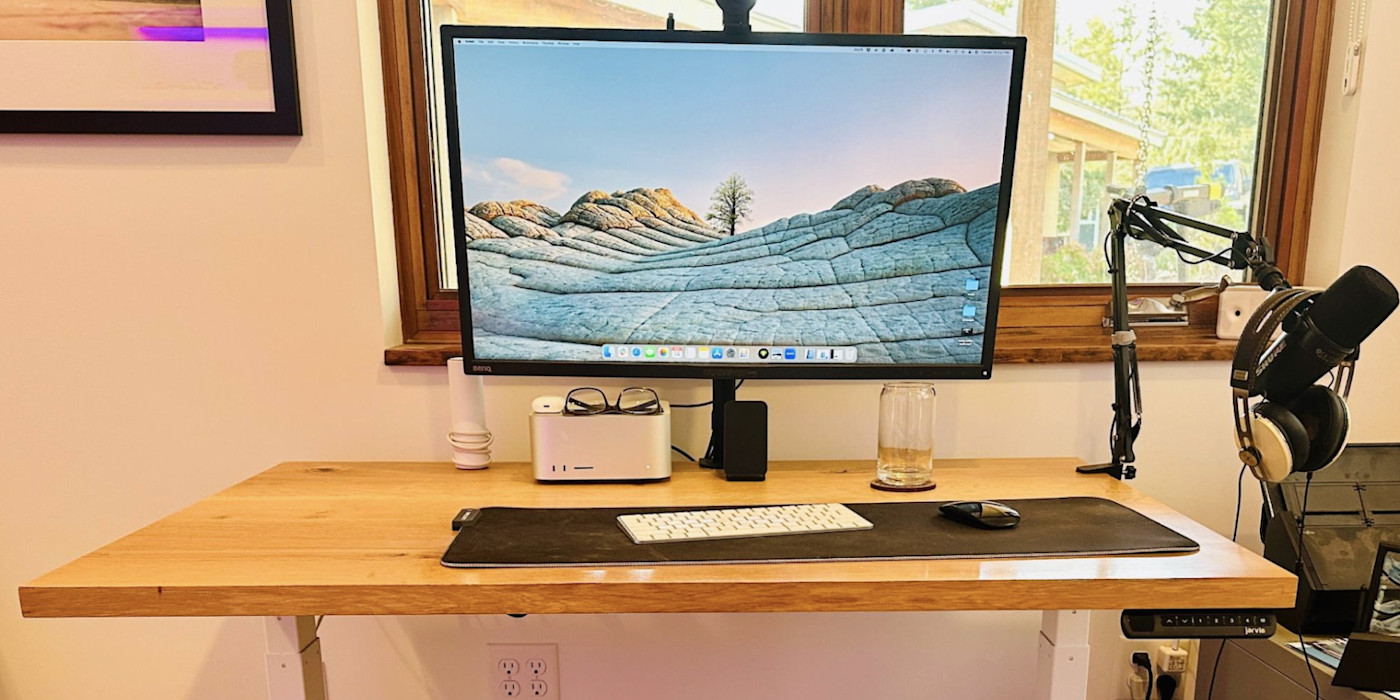Your workspace shouldn't wear you down every day, but that's what uncomfortable chairs, messy desks, and poor lighting do—even if you don't notice it. With a few adjustments, however, you can improve your working environment and keep your desk from destroying you, one aching limb at a time.
Here's everything you need to know about how to create an ergonomic desk setup and other ways to improve your workspace.
What is ergonomics?
Ergonomics is about designing environments, systems, and products to fit the people who use them. In the context of the workplace, the goal of ergonomics is to reduce strain, fatigue, and the risk of injury while improving the employee's efficiency, safety, and overall well-being. Some elements considered in workplace ergonomics include:
Workstation design: Setting up everyday tools, such as desks, chairs, and computer monitors, to support good posture and reduce strain.
Task design: Structuring tasks to minimize repetitive motions and excessive force.
Environmental factors: Addressing lighting, noise, and temperature to create a more comfortable work environment.
How to create an ergonomic desk setup and productive workstation at a glance
Here's a broad overview of the essential elements of a productive desk setup (keep scrolling for more details).
Ergonomic chair: Use a chair that provides lumbar support and allows you to sit comfortably with your knees at or slightly below your hip level, and rest your feet flat on the ground.
Desk height: Position the top of your desk high enough so that your arms remain parallel to the floor when typing.
Monitor height: Place your monitor roughly an arm's length away from your eyes and just high enough that the top line of your screen is at or below your eye level.
Keyboard: Position your keyboard close enough to your body so that your wrists rest flat or tilted downwards, and your elbows can be held comfortably at a 90-degree angle by your side.
Mouse: Use one that fits comfortably in your hands and allows your wrists to rest flat or tilted downwards.
Lighting: Give yourself as much exposure to daylight (or a desk lamp that simulates daylight) while working to improve your mood and focus.
Temperature: If you have control over your office thermostat, set it at a comfortable temperature—somewhere between 71.6 to 75.2°F (22 to 24°C).
Noise: Consider wearing noise-canceling headphones and pairing it with lo-fi beats or ambient noise to drown out distractions.
Plants: Add indoor plants around your office or workspace to prevent fatigue during attention-demanding work.
You can also download an infographic of these tips to keep them handy or share with your team.

How to set up your desk ergonomically
Here are the key elements of setting up your desk ergonomically so you can prevent common problems such as repetitive strain injury (RSI), back pain, and fatigue.
Ergonomic chair
If you spend most of your day at a desk, it's important to invest in an ergonomic chair. Unfortunately, shopping for a good office chair is about as easy as shopping for a mattress—so many options at so many price points and, again, no one size fits all. Also, manufacturers can slap the "ergonomic" label onto any product they want, including office chairs, so you can't go by that claim alone.
Instead, here's what to look for in an ergonomic office chair:
Lumbar support: The curve in the back of the chair should support your lower spine, following the natural curve of your lower back.
Seat depth: You should be able to sit comfortably with your lower back against the lumbar support and have about three or four fingers' width between your legs and the edge of your seat.
Chair height: When seated, your knees should be level with your hips or slightly below, and your feet should rest flat on the ground or on a footrest.
Armrests: These should be positioned so that your shoulders remain relaxed and your elbows rest comfortably at your sides, parallel to the floor.
Recline-ability: There are mixed reviews on the right chair posture (straight vs. slightly reclined). If you want to experiment with sitting at a slightly reclined angle, position your chair at roughly a 100- to 110-degree angle.
Before you purchase a chair, I recommend testing it out for at least 30 minutes in a setting similar to how you'd use it. For example, using the chair in front of a desk and typing on a keyboard.
Desk height

Just like with anything else, too much sitting or sitting for prolonged periods can be detrimental to your health. If you have the option to adjust the height of your desk so that you can alternate between sitting and standing, that's great. (It may even make you more productive.) If your only option is to sit, your desk should be positioned so that your forearms remain parallel to the ground as you type on your keyboard.
If your desk doesn't support the optimal seating position and adjusting your chair height isn't an option, you can modify other aspects, like adding a keyboard tray or putting the desk on risers.
Looking for the ideal desk height in numbers? As with everything else, the answer depends. But you can use Ergotron, a desk height calculator, to help you figure out the right settings based on your height and position.
Monitor height
How you set up your monitor matters, too. A too-high or too-low monitor could result in unwanted problems like eye strain, improper posture, and sore shoulders.
Here are a few guidelines to keep in mind when positioning your laptop or computer monitor:
Keep your monitor between 20 to 40 inches (roughly an arm's length) in front of you. If the monitor is too far away, you might be forced to lean forward, losing your back support. Too near, and your eyes have to work harder to focus. The right monitor distance should allow you to comfortably read all the text on your screen while maintaining proper posture.
Make sure the top line of the screen is at or below your eye level. If your monitor is too high, you'll be forced to strain your head, neck, and back. At the same time, your downward viewing angle shouldn't be greater than 60 degrees.
Don't tilt the monitor more than 10 to 20 degrees. More than that, and objects on the screen might be difficult to read.
Place the monitor perpendicular to the windows. This will help avoid eye-straining glare.
Even if your monitor is positioned at an ideal height, it's important to take breaks for your eyes. The 20-20-20 rule is a great way to reinforce consistent breaks: for every 20 minutes spent looking at a screen, look at something 20 feet away for 20 seconds.
Need help remembering to take breaks? Try using a Pomodoro timer app to break your work day into chunks with reminders to take breaks every so often.
Keyboard and mouse
If you find yourself regularly shaking out cramped wrists throughout your work day, there's a good chance your keyboard and mouse setup could use some adjustments.
Here's what the ideal keyboard setup looks like:
Close enough to your body so that you can comfortably hold your elbows at a 90-degree angle by your side, preventing shoulder fatigue.
Low enough that your forearm remains roughly parallel to the floor.
Placed at an angle that lets your wrists rest flat or tilted downwards.
No numeric keypad, so you can keep your mouse closer to your keyboard and avoid stretching your mouse-controlling arm too far out to the side.
A lot of standard keyboards are angled so the keyboard is higher than the front, causing our wrists to bend up while we type. One fix for this is to get a keyboard stand or tray that positions the keyboard at a downward angle. A cushy wrist rest that runs the length of your keyboard will also prevent your wrists from bending up.
If you use a laptop, you might consider pairing it with an external keyboard that you can reposition to meet the recommended setup.
And if you're in the market for a new keyboard, there are lots of ergonomic keyboards on the market. After 150 hours of testing keyboards, here are my recommendations.
Here's what the ideal mouse setup looks like:
As for your mouse itself, make sure it's a comfortable size for your hands. If it's too big or too small, you might end up bending your wrist in awkward positions.
Here are wireless mouse recommendations to suit different needs. If you're not interested in using a traditional mouse, there are also ergonomic mice and alternative input tools.
Posture
Whether you sit or stand at your desk, it's important to regularly take stock of your posture. Do you find yourself slowly hunching forward as the day wears on? Roll your shoulders back, sit up a little taller, and engage your core. Are your hips aching? Readjust your seated position so that your knees fall slightly below your hip level. You could even use a treadmill desk to walk and work.

And remember to take frequent breaks. It's counterintuitive, but taking frequent breaks can actually help boost your overall productivity.
How to set up a productive workstation
Now that we've covered how to set up your desk ergonomically, let's talk about an often-overlooked area that can impact your productivity: your work environment. Here are five workspace features to consider adjusting in your office or at-home setup, so you can get more done with less effort.
Lighting
The quality of your office lighting can affect your mood and well-being. Poor lighting, like the dim and harsh kind you get from overhead fluorescent lights, can cause eye strain, stress, and fatigue. Natural light, on the other hand, tends to reduce stress, improve mood and morale, and aid concentration. The benefits of getting exposure to daylight during your working hours also extend into your overall physical activity and sleep quality.
The reason why it's so important to get regular exposure to daylight? Sunlight helps our bodies maintain our circadian rhythms (think of them as internal clocks), which affects our sleep and energy, as well as our brains' release of serotonin, a hormone that helps us feel focused and calm.
If you have a say in where your office is, choose a room with natural light exposure. If you don't have control over the office lighting and can't claim a desk near a window, consider using your breaks to step outside to soak in that sunshine. Or opt for a light therapy desk lamp that simulates daylight.
Another thing to consider when it comes to lighting is the position of light sources. You want uniform light so that you can work without squinting, but you don't want your light to cause a glare on your monitor. For those reasons, avoid sitting directly in front of or with your back to a window unless you can draw the shades.
Temperature
As the old adage goes, you can't please everyone. To prove how true this statement is, look no further than the office thermostat.
Countless studies have been conducted in pursuit of the best ambient temperature to boost worker productivity. But before you scan ahead for the answer to "What's the best temperature?" here are some things to keep in mind:
Many of these studies were conducted with fewer than 100 participants, which is a limited sample size at best.
The best temperature depends on what you're trying to achieve. For example, some studies claim warm environments are better for creative thinking, while cooler workplaces are better for jobs that require you to stay alert during monotonous tasks.
Your biological makeup may play a role in what's right for you. In one study, the researcher found that women have significantly lower metabolic rates than men and may need their workspace to be 5.4°F (3°C) warmer.
All this to say that it's impossible to claim one temperature to suit everyone. But David Shipworth, a researcher at the UCL Energy Institute, suggests it may be somewhere between 71.6 to 75.2°F (22 to 24°C).
My best suggestion? Experiment with your office temperature, if you can, to find out what's best for you. If your office mates are less than keen on you playing with the thermostat, I'd recommend keeping a sweater or small fan handy.
Sound
There are good sounds to listen to while working, and then there's noise. Too often, we deal with the latter. Whether it's the sound of watercooler conversations traveling across your open-concept office, your neighbor's dog barking, or construction workers banging outside your window, it's hard to drown all that out when you're trying to work.
That's where a good pair of noise-canceling headphones come in. You can pair it with your favorite lo-fi soundtrack or, if you enjoy working with ambient noise, throw on some coffeehouse-like background chatter.
Plants
Can plants actually help you get work done? It might sound silly, but yes, a plant or two in your office can prevent fatigue during attention-demanding work.
If your track record of keeping plants alive is…not great, try a peace lily. It's a low-maintenance plant that doesn't require direct sunlight. It'll even signal when it needs watering by drooping miserably (the leaves will perk right back up once watered). If nothing else, resuscitating your plant on a regular basis might give you a small but notable sense of accomplishment.
It's worth mentioning that peace lilies can be mildly toxic if eaten, so if your workplace has pets or small children wandering around, try cacti or aloe plants instead.
The best desk layout for productivity

The cockpit of an aircraft puts all the flying controls and information panels needed within arm's reach for the pilot—and it leaves out extraneous information or anything that could be distracting. Ideally, your workspace functions similarly.
Here are a few things to keep in mind when organizing your desk:
Keep only the things you use daily within reach. If you reach for things like your favorite fine-tip pen and notebook on a daily basis, keep them nearby. And if you have limited desk space, consider turning the back of your monitor into a workspace utility belt.
Tuck less-frequently-used items away. Store supplies you might need weekly or monthly, such as extra Post-it notes and paperwork, in a filing cabinet or desk drawer.
Clear cable clutter with ties and other tools. Search for "cable clutter," and you'll find a ton of inexpensive tools, such as velcro ties that stick to the underside of your desktop, to inspiration involving more elaborate DIY projects.
If you can't remember the last time you saw the surface of your actual desk, here are some tips to help you declutter your desk.
If you move between offices, consider setting up your desk the same way in every space. This way, you can minimize the cognitive load it takes to reorient yourself every time you change locations.
Find what works best for you
There's no one-size-fits-all solution to setting up your desk or surroundings. Your workspace should be specific to you. It's where you do your life's work (or at least the work that helps pay the bills). It should support both your well-being and how you work best. Use the above tips to help you find your optimal desk setup so you can have productive work days—and enough energy to have a life after work, too.
Related reading:
This article was originally published in July 2016. The most recent update was in September 2023 with contributions from Jessica Lau. (Title photo by MKBHD via Reddit.)





